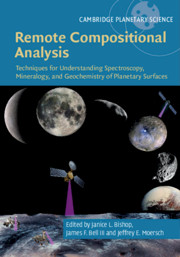 Remote Compositional Analysis
Remote Compositional Analysis from Part IV - Applications to Planetary Surfaces
Published online by Cambridge University Press: 15 November 2019
Multispectral imaging – the acquisition of spatially contiguous imaging data in a modest number (~3–16) of spectral bandpasses – has proven to be a powerful technique for augmenting panchromatic imaging observations on Mars focused on geologic and/or atmospheric context. Specifically, multispectral imaging using modern digital CCD photodetectors and narrowband filters in the 400–1100 nm wavelength region on the Mars Pathfinder, Mars Exploration Rover, Phoenix, and Mars Science Laboratory missions has provided new information on the composition and mineralogy of fine-grained regolith components (dust, soils, sand, spherules, coatings), rocky surface regions (cobbles, pebbles, boulders, outcrops, and fracture-filling veins), meteorites, and airborne dust and other aerosols. Here we review recent scientific results from Mars surface-based multispectral imaging investigations, including the ways that these observations have been used in concert with other kinds of measurements to enhance the overall scientific return from Mars surface missions.
To save this book to your Kindle, first ensure [email protected] is added to your Approved Personal Document E-mail List under your Personal Document Settings on the Manage Your Content and Devices page of your Amazon account. Then enter the ‘name’ part of your Kindle email address below. Find out more about saving to your Kindle.
Note you can select to save to either the @free.kindle.com or @kindle.com variations. ‘@free.kindle.com’ emails are free but can only be saved to your device when it is connected to wi-fi. ‘@kindle.com’ emails can be delivered even when you are not connected to wi-fi, but note that service fees apply.
Find out more about the Kindle Personal Document Service.
To save content items to your account, please confirm that you agree to abide by our usage policies. If this is the first time you use this feature, you will be asked to authorise Cambridge Core to connect with your account. Find out more about saving content to Dropbox.
To save content items to your account, please confirm that you agree to abide by our usage policies. If this is the first time you use this feature, you will be asked to authorise Cambridge Core to connect with your account. Find out more about saving content to Google Drive.